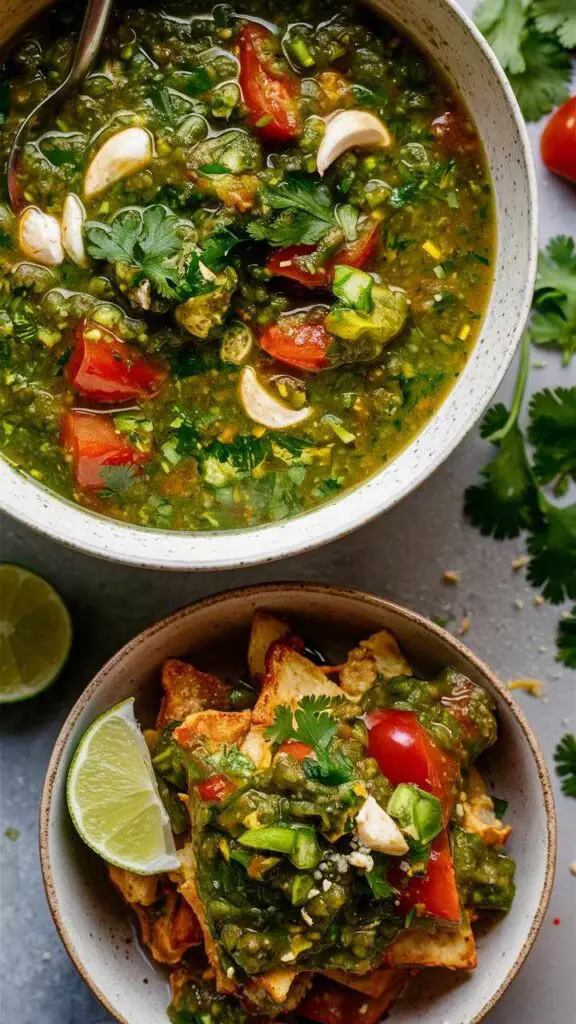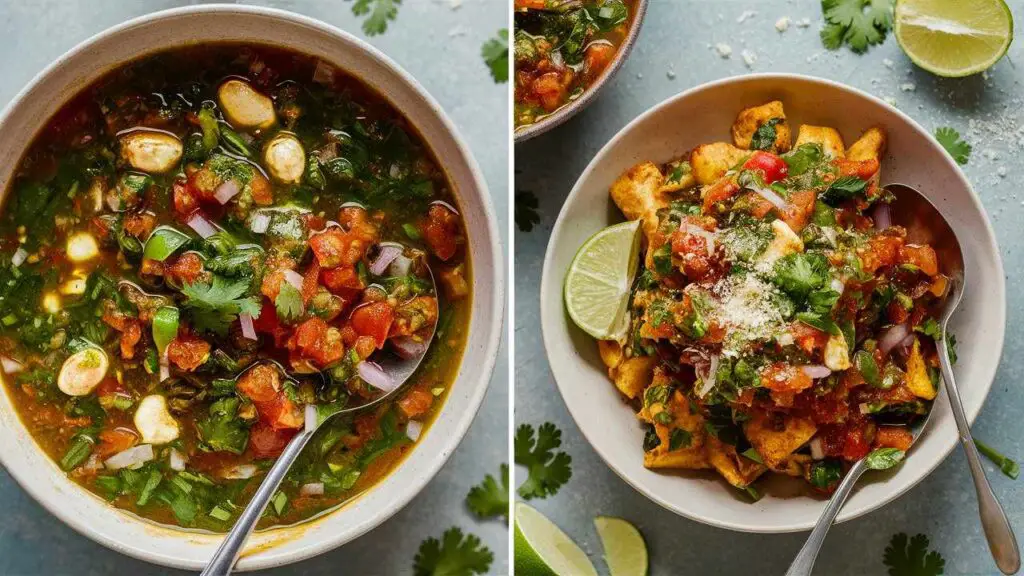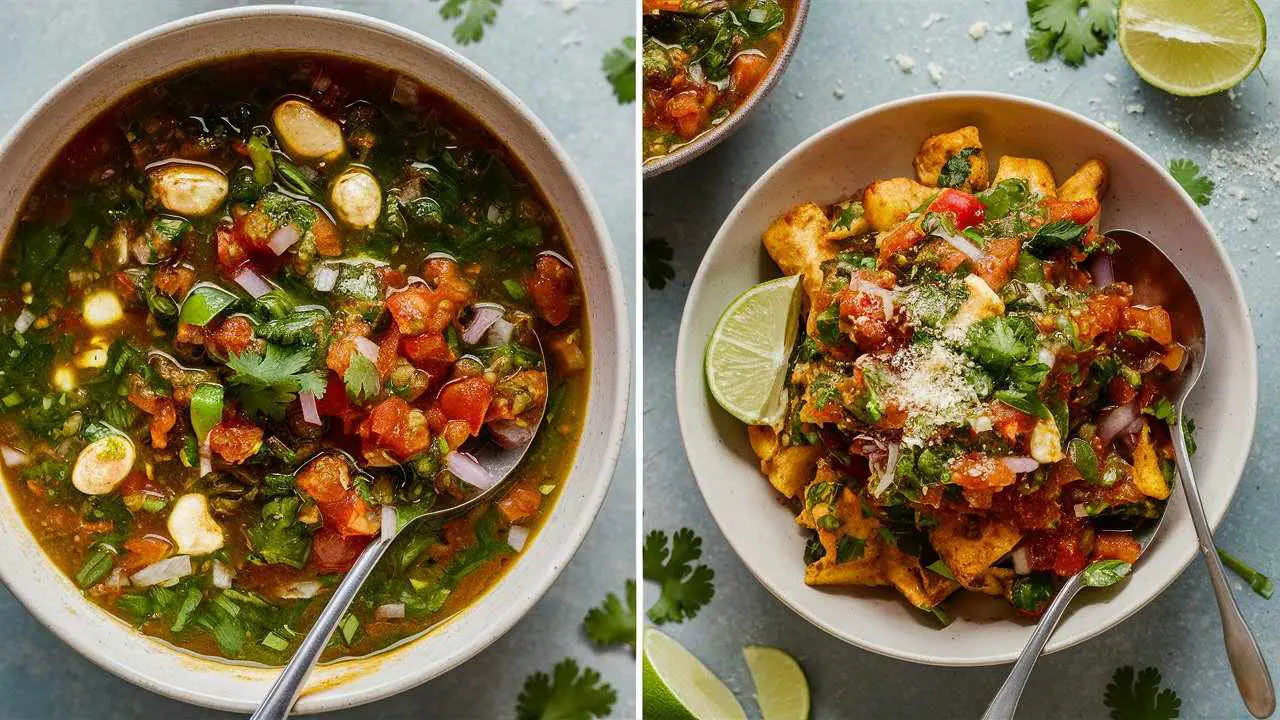If you’re a true connoisseur of Mexican cuisine, you’ve likely savored the delightful combination of crispy tortilla chips drenched in a vibrant green salsa, known as Chilaquiles. This iconic dish is a beloved staple in households across Mexico and beyond, offering a harmonious blend of textures and flavors that tantalizes the taste buds. Today, we embark on a culinary adventure, unveiling the secrets behind crafting the perfect Salsa Verde Para Chilaquiles – a dish that will transport you to the heart of Mexican gastronomy.

Ingredients
To embark on this flavorful journey, you’ll need to gather the following ingredients:
- 18 corn tortillas (approximately 13 cm in diameter)
- 1 kg green tomatoes (tomatillos), peeled and washed
- 1/2 large white onion
- 1-2 serrano or jalapeño chilies (adjust quantity based on desired heat level)
- 1 garlic clove
- 2-3 sprigs of fresh cilantro
- 2 cups of chicken or vegetable broth
- 3 tablespoons of vegetable oil, plus additional for brushing the tortillas
For the Garnish:
- 1/2 cup thinly sliced onion
- 1/4 cup chopped fresh cilantro
- 1/2 cup crumbled queso fresco or cotija cheese
- 1/4 cup Mexican crema (or sour cream)
Timing
- Preparation Time: 20 minutes
- Cooking Time: 45 minutes
- Total Time: 1 hour 5 minutes
Step-by-Step Guide to Making Salsa Verde Para Chilaquiles
Step 1- Prepare the Tortilla Chips: Preheat your oven to 150°C (300°F). Cut the corn tortillas into wedges or triangles, approximately 5 cm (2 inches) in size. Lightly brush the tortilla pieces with vegetable oil and sprinkle with salt. Arrange them on a baking sheet and bake for 15-20 minutes, or until crispy and lightly golden. Alternatively, you can fry the tortilla pieces in hot oil until crisp. Set aside the tortilla chips to cool.
Step 2- Make the Salsa Verde: Preheat your oven to 175°C (350°F). Place the green tomatoes (tomatillos), onion, garlic clove, and serrano or jalapeño chilies in a baking dish. Drizzle with about 1 tablespoon of vegetable oil, ensuring all the ingredients are lightly coated. Sprinkle with salt and roast in the preheated oven until the tomatoes are softened and the ingredients are slightly charred, about 15-20 minutes.
Step 3- Blend the Salsa: Transfer the roasted vegetables, along with the cilantro and chicken or vegetable broth, to a blender. Blend until you achieve a smooth, well-combined salsa. Adjust the consistency by adding more broth if the salsa is too thick.
Step 4- Cook the Salsa: In a saucepan or skillet, heat the remaining 2 tablespoons of vegetable oil over medium heat. Once hot, carefully pour in the blended salsa and simmer for about 10 minutes, allowing the flavors to meld and the salsa to thicken slightly. Season with salt to taste.
Step 5- Assemble the Chilaquiles: In a large baking dish or oven-safe skillet, layer half of the crispy tortilla chips. Top with half of the shredded chicken (if using), followed by half of the salsa verde. Repeat the layers with the remaining tortilla chips, chicken, and salsa verde, finishing with a generous sprinkling of crumbled queso fresco or cotija cheese.
Step 6- Bake and Serve: Reduce the oven temperature to 375°F (190°C). Bake the assembled chilaquiles for 3-5 minutes, or until the cheese melts and the dish is heated through. Remove from the oven and garnish with sliced onions, chopped cilantro, crema (or sour cream), and any additional desired toppings.

Roasting vs. Boiling: Methods for Preparing Salsa Verde
When it comes to preparing Salsa Verde, there are two primary methods: roasting or boiling the ingredients. Each technique imparts distinct flavors and textures to the final dish.
Roasting Method:
Roasting the tomatillos, onions, garlic, and chilies in the oven is a preferred method for many home cooks. This process caramelizes the natural sugars in the vegetables, resulting in a deeper, richer flavor profile. The charred edges of the roasted ingredients add a delightful smoky note to the salsa, enhancing its complexity.
Boiling Method:
Alternatively, some recipes call for boiling the tomatillos and chilies before blending them into a salsa. This method is often quicker and more straightforward, but it can result in a slightly more acidic and brighter flavor. Boiling helps to soften the ingredients, making them easier to blend into a smooth consistency.
Both methods have their merits, and the choice ultimately depends on personal preference and the desired flavor profile. Roasting tends to be the more traditional approach, but boiling can be a convenient option for those short on time or seeking a lighter, more vibrant salsa.
Tips for Achieving the Perfect Consistency in Salsa Verde
The consistency of Salsa Verde is a crucial aspect that can make or break the dish. Too thick, and it may overpower the crispy tortilla chips; too thin, and it may lack the desired body and cling. Here are some tips to help you achieve the perfect consistency:
-
Adjust the Liquid: The amount of liquid (broth or water) added to the blender can significantly impact the salsa’s consistency. Start with a smaller amount and gradually add more until you reach the desired thickness. Remember, you can always thin out a thick salsa, but it’s harder to thicken a runny one.
-
Blend Thoroughly: Ensure that all the ingredients are blended until smooth, with no visible chunks or pieces remaining. A high-powered blender or immersion blender can help achieve a velvety texture.
-
Strain or Purée: If you prefer a smoother, silkier salsa, consider straining the blended mixture through a fine-mesh sieve or using a food mill to remove any remaining solids or seeds.
-
Simmer and Reduce: After blending, simmering the salsa on the stovetop for a few minutes can help thicken it to the desired consistency. The longer you simmer, the thicker the salsa will become, so keep an eye on it and adjust the heat accordingly.
-
Adjust with Thickeners: If the salsa remains too thin after simmering, you can try adding a small amount of masa harina (corn flour) or a purée of cooked potatoes or bread to help thicken it without altering the flavor too much.
Remember, the perfect consistency is a matter of personal preference, so don’t be afraid to experiment and adjust the salsa to your liking.
How to Assemble Chilaquiles with Salsa Verde
Once you’ve mastered the art of preparing the crispy tortilla chips and the flavorful Salsa Verde, it’s time to bring these components together to create the ultimate Chilaquiles dish. Here’s how you can assemble this Mexican delight:
-
Layer the Tortilla Chips: In a large baking dish or oven-safe skillet, arrange a single layer of crispy tortilla chips. This will serve as the base for your Chilaquiles.
-
Add the Salsa Verde: Generously spoon the freshly made Salsa Verde over the tortilla chips, ensuring they are evenly coated and well-saturated with the vibrant green sauce.
-
Incorporate Protein (Optional): If desired, you can add a layer of shredded or diced cooked chicken, beef, or pork between the layers of tortilla chips and salsa. This will transform your Chilaquiles into a heartier, more substantial meal.
-
Repeat the Layers: Continue layering the tortilla chips, salsa verde, and protein (if using) until you’ve used up all the ingredients or reached your desired portion size.
-
Top with Cheese: Finish off the assembled Chilaquiles by sprinkling a generous amount of crumbled queso fresco, cotija cheese, or your preferred cheese variety over the top layer.
-
Bake or Heat: If you’ve assembled the Chilaquiles in an oven-safe dish, place it in a preheated oven (375°F/190°C) and bake for 3-5 minutes, or until the cheese melts and the dish is heated through. Alternatively, you can heat the assembled Chilaquiles in a skillet or pan on the stovetop, covering it with a lid to help the cheese melt.
Remember, the beauty of Chilaquiles lies in the contrast between the crispy tortilla chips and the velvety Salsa Verde, so aim for a balance of textures and flavors in each bite.
Best Toppings for Chilaquiles with Salsa Verde
While the combination of crispy tortilla chips, tangy Salsa Verde, and melted cheese is undeniably delicious, the right toppings can elevate your Chilaquiles to new heights of flavor and texture. Here are some of the best toppings to consider:
1- Sliced Onions: Thinly sliced red or white onions add a crisp, pungent flavor and a refreshing crunch to the dish.
2- Fresh Cilantro: Chopped fresh cilantro not only adds a vibrant pop of color but also contributes a bright, herbal note that complements the Salsa Verde beautifully.
3- Crema or Sour Cream: A dollop of Mexican crema or sour cream adds a cool, creamy contrast to the bold flavors of the Chilaquiles, helping to balance the heat and acidity.
4- Avocado: Sliced or diced avocado adds a rich, buttery texture and a subtle nutty flavor that pairs exceptionally well with the tangy salsa.
5- Radishes: Thinly sliced radishes provide a refreshing crunch and a peppery kick, cutting through the richness of the dish.
6- Queso Fresco or Cotija Cheese: In addition to the melted cheese in the layers, a sprinkling of crumbled queso fresco or cotija cheese on top adds a salty, tangy punch.
7- Fried Eggs or Chorizo: For a heartier meal, top your Chilaquiles with a fried egg or crumbled chorizo, adding protein and extra richness.
8- Lime Wedges: A squeeze of fresh lime juice can brighten up the flavors and add a zesty note to the dish.
Feel free to mix and match these toppings to create your perfect combination of flavors and textures, or experiment with other ingredients that appeal to your taste preferences.
Serving Suggestions for Chilaquiles with Salsa Verde
Chilaquiles with Salsa Verde is a versatile dish that can be enjoyed for breakfast, brunch, lunch, or even dinner. Here are some serving suggestions to help you make the most of this delectable Mexican treat:
Breakfast or Brunch:
Chilaquiles make for a delightful and hearty breakfast or brunch option. Serve them alongside a side of refried beans, fresh fruit salad, or a warm cup of Mexican hot chocolate for a truly indulgent morning meal.
Lunch or Dinner:
For a more substantial lunch or dinner, consider pairing your Chilaquiles with a refreshing salad, such as a classic Caesar salad or a vibrant Mexican-inspired salad with mixed greens, avocado, and a tangy vinaigrette dressing.
Appetizer or Snack:
If you’re hosting a gathering or simply craving a flavorful snack, Chilaquiles can be served in smaller portions as an appetizer or shared plate. Arrange them in individual ramekins or small bowls, garnished with your favorite toppings, and let your guests indulge in the deliciousness.
Meal Prep:
Chilaquiles with Salsa Verde can also be a convenient meal prep option. Prepare the components in advance and store them separately in the refrigerator. When ready to enjoy, simply assemble and reheat, ensuring the tortilla chips maintain their crispness.
No matter how you choose to serve them, Chilaquiles with Salsa Verde are sure to delight your taste buds and transport you to the heart of Mexican culinary traditions.
Health Benefits of Homemade Salsa Verde
While Chilaquiles may not be the first dish that comes to mind when thinking about healthy eating, the homemade Salsa Verde component of this dish offers a wealth of nutritional benefits. Here are some of the health advantages of incorporating homemade Salsa Verde into your diet:
-
Rich in Vitamins and Minerals: Tomatillos, the main ingredient in Salsa Verde, are an excellent source of vitamins C, K, and niacin, as well as minerals like potassium, manganese, and iron. These nutrients support a healthy immune system, promote bone health, and aid in various bodily functions.
-
High in Antioxidants: The vibrant green color of Salsa Verde is a testament to its antioxidant content. Tomatillos, cilantro, and chilies are rich in plant compounds like lutein, zeaxanthin, and capsaicin, which help neutralize harmful free radicals and reduce oxidative stress in the body.
-
Supports Digestive Health: The fiber content in tomatillos and onions, combined with the probiotic properties of fermented tomatillos (if used), can promote a healthy gut and support regular digestion.
-
Low in Calories and Fat: Compared to many other sauces and condiments, homemade Salsa Verde is relatively low in calories and fat, making it a flavorful addition to dishes without compromising your dietary goals.
-
Potential Anti-Inflammatory Properties: The capsaicin found in chilies, along with other plant compounds in the ingredients, may have anti-inflammatory effects, helping to reduce inflammation in the body.
By incorporating homemade Salsa Verde into your Chilaquiles or using it as a flavorful topping for other dishes, you can enjoy a delicious and nutritious addition to your meals.
Nutritional Facts
Serving Size: 1 cup (240g)
- Calories: 120
- Total Fat: 4g
- Saturated Fat: 0.5g
- Cholesterol: 0mg
- Sodium: 460mg
- Total Carbohydrates: 19g
- Dietary Fiber: 4g
- Total Sugars: 7g
- Protein: 3g
Vitamin and Mineral Content:
- Vitamin C: 30% of the Daily Value (DV)
- Vitamin K: 15% of the DV
- Potassium: 10% of the DV
- Vitamin A: 8% of the DV
- Iron: 6% of the DV
Please note that these nutritional values are approximate and may vary depending on the specific ingredients and portion sizes used.
Conclusion
Salsa Verde Para Chilaquiles is a true celebration of Mexican culinary heritage, bringing together the vibrant flavors of tomatillos, chilies, and aromatic herbs in a harmonious dance. By following the step-by-step guide and incorporating the tips and techniques shared in this article, you can recreate this beloved dish in the comfort of your own kitchen.
Whether you’re a seasoned home cook or a curious culinary explorer, the process of crafting homemade Salsa Verde and assembling the perfect Chilaquiles is a rewarding and satisfying experience. From the tantalizing aroma of roasted vegetables to the crunch of crispy tortilla chips drenched in the velvety green sauce, each bite is a testament to the rich culinary traditions of Mexico.
So, gather your ingredients, roll up your sleeves, and embark on this flavorful journey. Salsa Verde Para Chilaquiles is not just a dish; it’s a culinary adventure that will transport you to the vibrant streets of Mexico, one mouthwatering bite at a time.
FAQs
Can I use store-bought salsa instead of making it from scratch?
While store-bought salsa can be a convenient option, homemade Salsa Verde offers a unmatched freshness and depth of flavor. However, if you’re short on time, you can use a high-quality store-bought salsa verde as a base and enhance it with additional fresh ingredients like cilantro, lime juice, or roasted garlic to elevate the flavors.
Can I make the salsa verde in advance?
Absolutely! Salsa verde can be prepared a day or two in advance and stored in an airtight container in the refrigerator. This allows the flavors to meld and develop even further. Just be sure to give it a good stir before using and adjust the consistency if needed by adding a splash of broth or water.
Can I use flour tortillas instead of corn tortillas?
While corn tortillas are the traditional choice for chilaquiles, you can certainly use flour tortillas if that’s your preference. Keep in mind that flour tortillas tend to be softer and may not achieve the same level of crispness as their corn counterparts. If using flour tortillas, you may need to fry or bake them for a longer period to achieve the desired crunchiness.
Can I make chilaquiles with leftover tortilla chips?
Yes, chilaquiles are an excellent way to repurpose leftover tortilla chips. Simply skip the step of frying or baking the tortillas and use your leftover chips instead. However, be mindful that stale or overly hard chips may not soak up the salsa as well as freshly fried or baked ones.
Can I make chilaquiles vegan or vegetarian?
Absolutely! Chilaquiles can easily be made vegan or vegetarian by omitting the chicken and using vegetable broth instead of chicken broth in the salsa verde. You can also substitute the cheese topping with a vegan alternative or simply omit it altogether.
Can I add other ingredients to the salsa verde?
Salsa verde is a versatile base that can be customized to suit your taste preferences. You can experiment with adding ingredients like roasted garlic, cumin, oregano, or even a touch of vinegar or lime juice to enhance the flavors. Just be mindful of not overpowering the fresh, vibrant taste of the tomatillos and chilies.
How can I adjust the heat level of the salsa verde?
The heat level of the salsa verde can be easily adjusted by increasing or decreasing the number of chilies used. For a milder salsa, remove the seeds and membranes from the chilies before blending. Conversely, if you prefer a spicier kick, add an extra chili or two to the mix.
Can I freeze leftover salsa verde?
Yes, leftover salsa verde can be frozen for later use. Simply portion it into airtight containers or freezer-safe bags, leaving some headspace for expansion. Thaw the salsa in the refrigerator overnight before using it, and you may need to adjust the consistency by adding a splash of broth or water after thawing.
By addressing these frequently asked questions, you’ll be better equipped to tackle any challenges or variations that may arise when preparing this delectable dish. Embrace the versatility of Salsa Verde Para Chilaquiles and make it your own culinary masterpiece.
